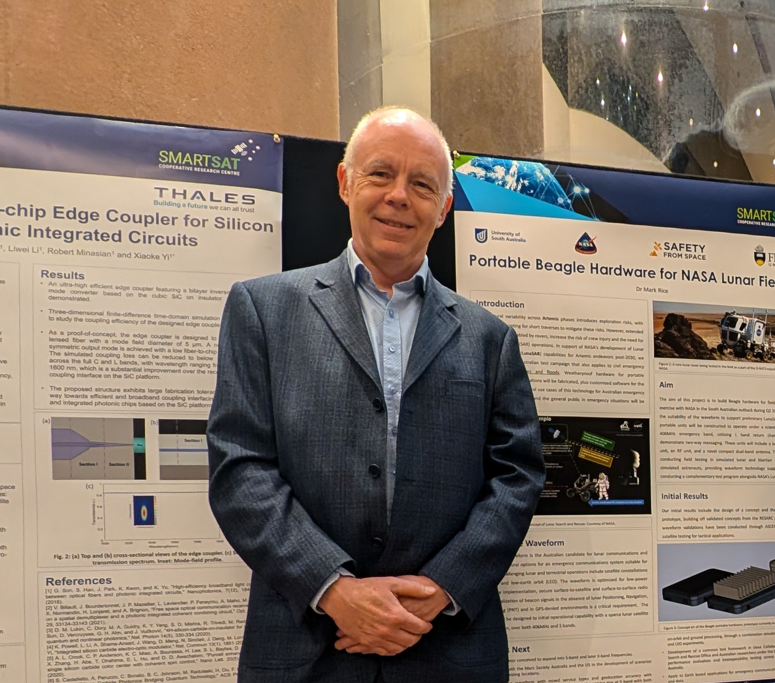A team of international scientists has taken a significant step towards making lunar exploration safer, proposing a distress monitoring and rescue system designed for the Moon’s unique and challenging environment.
As NASA’s Artemis program aims to establish a long-term human presence on the Moon, astronauts will be exposed to high-risk situations in remote areas like the lunar south pole.
A project led by the University of South Australia (UniSA), addresses the critical need for an emergency system capable of providing safety alerts, incident reporting, and location tracking of astronauts in distress.
Researchers from Adelaide and the US are designing a satellite constellation that prioritises communication and geolocation on the Moon’s surface. Using this system, astronauts will be able to send distress signals to a network of satellites that will relay the information back to Earth or other lunar bases.
The system is based on the COSPAS-SARSAT technology already used for search and rescue on Earth, adapted for lunar conditions.
Dr Mark Rice, a UniSA adjunct researcher and founder of Safety from Space, says the distress system could allow continuous communication with astronauts for up to 10 hours, even in the most challenging terrain, such as craters or mountains.
“Our team has also developed a waveform that supports low-power emergency beacons, ensuring that communication remains possible with minimal infrastructure and energy consumption,” Rice says.
“This innovation is a critical advancement for space exploration. As humans venture further into space, the ability to quickly locate and rescue individuals in distress is vital.
“By creating a robust search and rescue system for the Moon, this research sets the foundation for similar systems on other planets, potentially revolutionising how we approach human safety in space exploration.”
Saving lives on the ground
Closer to home, the technology – called Beagle – has been described as a ‘game-changer’ for two-way emergency communications when applied to Earth-based search and rescue operations. This would enhance emergency response efforts in remote and hazardous locations, potentially saving countless lives, the researchers say.
The work, supported by the SmartSat CRC and Flinders University, was presented to a recent International Communications and Satellite Systems (ICSSC) conference.
Rice told EducationDaily he started talking with people from emergency services: police, fire, SES, volunteers in 2018, when he joined the UniSA Innovation and Collaboration Centre (ICC) Incubator, which started Safety from Space.
Safety from Space was founded with the support of UniSA’s Innovation and Collaboration Centre. The start-up has recently been awarded $100,000 from the SA Government to help drive the Lunar Search and Rescue project, with an anticipated field trial with NASA in 2025.

” I heard the stories about the challenges in responding: receiving a call for help, locating, gathering information, and sending a response. And I knew that we could find a solution with satellite technology,” he says.
“I heard the stories about the challenges in responding: receiving a call for help, locating, gathering information, and sending a response. And I knew that we could find a solution with satellite technology.
“I had a long relationship with NASA through the COSPAS-SARSAT emergency beacon technical working group and they got onboard, and came to me with the future problem of keeping lunar astronauts alive when there is a solar flare event or accident happens during a moon walk.
“So, I hope we can help to keep future astronauts safer than they would be otherwise and save lives here on Earth with the same technology.”
Making a positive difference for those working under extreme conditions
Rice describes the start-up as “one of these instant breakthroughs after 20 years of preparation”.
“The inspiration was my old boss and mentor, Professor Michael Miller, who gave us the confidence to aim high. If we can save one life, we will be very happy.”
The technology was initially tested on Earth and has direct application to places where the network coverage is limited, degraded or non-existent, Rice told EducationDaily, adding that this application is even more important as “we face more extreme climate challenges”, such as bush fire, flood and other extreme weather.
“In a remote emergency, if you don’t know the location and what has happened quickly, the situation can become very serious. Aside from prompting a rescue when someone is in a dire situation, there is a huge cost associated with searching and mounting a mission in difficult terrain,” he says.
Rice told EducationDaily his passion for innovation is driven by “meeting the emergency service operators, the medical team, the volunteers who operate with limited resources under extreme conditions”.
“There will be a growing number of visitors to the lunar surface and future Mars missions who will put their lives on the line,” he says.
“Our own Katherine Pennell-Begg may be one of these. They need to be located and communicated with when things don’t go to plan.”








